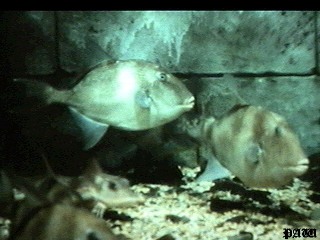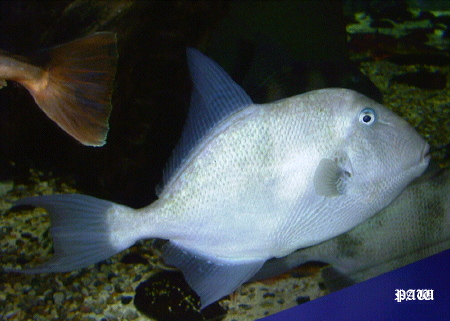Identification:
Side profile is a deep oval, with a short tapered posterior section leading
to the tail fin, with it's long streaming outer rays. The body is covered
with toughened scales.The enlarged head accounts for almost a third of the
total length, and is characterised by the small mouth, with it's large frontal
set teeth, giving rise to the parrot bill appearance.
The dorsal fin consists of two separate sections. The anterior portion, which
lies above and slightly forward of the pectoral fin, is composed of 3 stout
and roughened spines. These decrease in size towards the posterior and are
membrane bound. The these act in unison, so that the first spine cannot be
depressed until the second has done so. This spine arrangement of the anterior
dorsal fin is used by the fish, to wedge itself into available crevices,
and make it's extraction very difficult.The posterior dorsal fin, has a very
similar shape to that of the anal fin. Both are wide based rayed fins, with
a high frontage.The pelvic fin is a vestigial roughened spine.
The back tends to be a greyish to olive brown in colour, that is mottled,
and may give rise to a number of wide vertical bands, all of which fade towards
the pale lower sides, and white belly.The fins have a peppering of pale bluish
dots and lines, especially towards their bases.
Breeding:
Nest-pit builders, with the eggs being deposited
in the cavity excavated by the female, during the summer, and guarded
by the male. Unsure if they now breed in UK waters.
Habitat:
Tends to be a mid-water fish (5 to 30m), of rocky substrates and wrecks.
Shoals tend to be bound very closely to their relatively small territories
once they arrive here in the spring and summer.This fish has undergone a
population, and distribution expansion, along the southern and western coasts
of the UK, since the early 1980's.
Food:
Diet would seem to mainly consist of molluscs and crustaceans.
Range:
Found up to the North Western coasts of Scotland,
but more commonly associated with the Southern and Western shores of the
UK.
Additional Notes:
|

